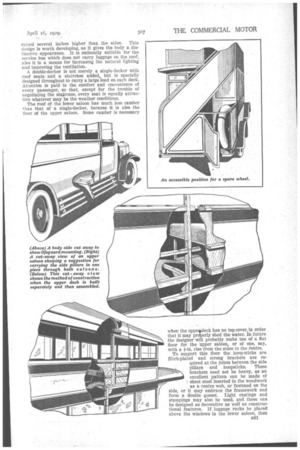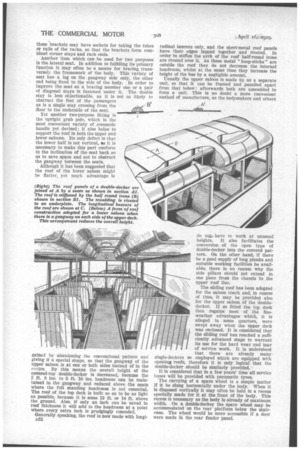Pointers in BUS-BODY DESIGN and CONSTRUCTION
Page 100

Page 101

Page 102

If you've noticed an error in this article please click here to report it so we can fix it.
Features of Current Practice and Directions in which Design is Likely to Progress in the Building of Single-deck and Double-saloon Municipal Buses.
THE design and construction of the single-deck and double-deck bus body is continually being improved. There is always the opportunity for the introduction of new ideas, because of the many styles of coachwork as well as the large number of fittings with which the bus is equipped, In order that its efficiency as a passenger-transport unit shall be enhanced. The single-decker is often much better described as a saloon coach, because, whether it be for service duty or long-distance work, every effort is made to give the vehicle an attractive outline, which will also promote speed and safety. The single-deck service bus is a type which gives scope for going closely into the question of weight reduction, especially when no top load of luggage is carried. Some builders prefer to use roof boards, and, if these be thin as well as narrow, they can be laid, without much trouble, over the sides and ends of the roof where the surfaces are sharply curved. On the other hand, plywobd panels are often employed. If this material be not used for the canopy ends, then aluminium panels will often be adopted. As a fabric-covered roof is now used for the majority of closed private cars and is found to be reliable, it is suggested that a similar design might be tried for the publicservice vehicle. Occasionally t h e
single-decker i s made with a clerestory roof, that is, the central portion (about one-third) is raised several inches higher than the sides. This design is worth developing, as it gives the body a distinctive appearance. It is eminently suitable for the service bus which does not carry luggage on the roof, also it is a means for increasing the natural lighting and improving the ventilation. A. double-decker is net merely a single-decker with roof seats and a staircase added, but is specially designed throughout to carry a large load on each deck. Attention is paid to the comfort and convenience of every passenger, so that, except for the trouble of negotiating the staircase, every seat is equally attractive whatever may be the weather conditions.
The roof of the lower saloon has much less camber than that of a single-decker, because it is also the floor of the upper saloon. Some camber is necessary
when the uppeapdeck has no top cover, in order that it may prdperly shed the water. In future the designer will probably make use of a flat floor for the upper saloon, or of one, say, with a j-in. rise from the sides to the entre.
To support this floor the hoop-sticks are flitch-plated and strong brackets are required at the joints between the side pillars and hoopsticks. These brackets need not be heavy, as an excellent pattern can be made of sheet steel inserted in the woodwork as a centre web, or fastened on the side, or it may embrace the framework and form a double gusset. Light castings and stampings may also be used, and these can be designed as decorative as well as constructional features. If luggage racks be placed above the windows in the lower saloon, then these brackets may have sockets for taking the tubes or rails of the racks, so that the brackets form combined corner stays and rack ends.
Another item which can be used for two purposes is the lateral seat. In addition to fulfilling its primary function it may often be a means for bracing transversely the framework of the body. This variety of seat has a leg on the gangway side only, the other end being fixed to the side of the body. In order to improve the seat as a bracing member one or a pair of diagonal stays is fastened under it. The double stay is less objectionable, as it is not so likely to obstruct the feet of the passengers as is a single stay crossing from the floor to the underside of the seat..
Yet another two-purpose fitting is the upright grab pole, which is the most convenient variety of commode handle yet devised; it also helps to support the roof in both the upper and lower saloons. Its only defect is that the lower half is not vertical, as it is necessary to make this part conform to the inclination of the seat back so as to save space and not to obstruct the gangway between the seats.
Although it has been suggested that the roof of the lower saloon might be flatter, yet much advantage is gained by abandoning the conventional pattern and giving it a special shape, so that the gangway of the upper saloon is at one or both sides instead of in the centre. By this means the overall height of the covered-top double-decker is decreased, because the 5 ft. 8 ins. to 5 ft. 10 ins, headroom can be maintained in the gangway and reduced above the seats where the full standing headroom is not essential. The roof of the top deck is built so as to be as light as possible, because it is some 13 ft. or 14 ft. above the ground. Also, if only an inch can be saved in roof thickness it will add to the headroom at a point where every extra inch is grudgingly conceded. Generally speaking, the roof is now made with longiD32 tudinal bearers only, and the sheet-metal roof panels have their edges lapped together and riveted. In order to stiffen the arch of the roof half-round irons are riveted over it. As these metal "hoop-sticks" are outside the roof they do not decrease the internal headroom, whilst at the same time they increase the height of the bus by a negligible amount.
Usually the upper saloon is made up as a separate unit, so that it can be framed and panelled apart from that below; afterwards both are assembled to form a unit. This is no doubt a more convenient method of manufacture, as the bodymakers and others A', do net., have to work at unusual heights. It also facilitates the conversion of the open type of double-decker into the covered pattern. On the other hand, if there be a good supply of long planks and suitable working facilities be available, there is• no reason why the side pillars should not extend in one piece from the chassis to the upper roof line.
The sliding roof has been adopted for the saloon coach and, in course of time, it may be provided also for the upper saloon of the doubledecker. If so fitted the top deck then regains most of the fineweather advantages which, it is alleged in some quarters, were swept away when the upper deck was enclosed. It is considered that the sliding roof has reached a sufficiently advanced stage to warrant its use for the hard wear and tear of service work. It is understood that there are already many single-deckers so employed which are equipped with openina roofs, therefore it is only logical that the double-decker should be similarly provided.
It is considered that in a few years' time all service buses will be provided with pneumatic tyres.
The carrying of a spare wheel is a simple matter if it be slung horizontally under the body. When it is disposed vertically it may often be held in a recess specially made for it at the front of the body. This recess is necessary as the body is already of maximum width. On a double-decker the spare wheel may be accommodated on the rear platform below the staircase. The wheel would be more accessible if a door were made in the rear fender panel.








































































































































































































